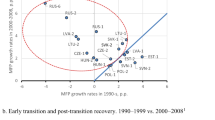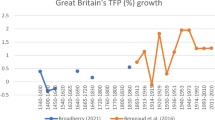Abstract
Using the latest (2016) version of the India KLEMS Dataset and following the KLEMS approach this paper analyzes growth, structural change and productivity advance in the Indian economy in the period 1980–2014. The KLEMS approach takes into account the roles played by capital, labour, energy, materials and services inputs in output growth by industries. In our analysis, we divide the span of 35 years into three sub-periods, 1980–1993, 1994–2002 and 2003–2014. The analysis reveals that value added growth at the economy level accelerated significantly during 2003–2014 by about 1.7 percentage points per annum to 7.2%, which was accompanied by accelerated total factor productivity (TFP) growth, acceleration by about 0.9 percentage points to 1.8% per year. The contribution of TFP growth to aggregate value added growth was much higher during 2003–2014 than that during 1980–2002. The share of Market Services sector in aggregate value added was on the rise, with a falling share of Agriculture. When measured by double deflated value added, the share of Manufacturing in aggregate value added also increased, a rise by about 12 percentage points between 1980 and 2014. The 0.9 percentage point hike in the aggregate level TFP growth rate during 2003–2014 was contributed by acceleration in the rate of TFP growth achieved by Manufacturing, Market Services and Agriculture sectors, in that order. Factor reallocations across industries, shift of labour and capital from lower productivity to high productivity industries, made a major contribution to growth in labour productivity, capital productivity and TFP, especially during 2003–2014.

Source: Authors’ computations from India KLEMS dataset, 2016

Source: Authors’ computations from India KLEMS dataset, 2016

Source: Authors’ computations from India KLEMS dataset, 2016

Source: Authors’ computations from India KLEMS dataset, 2016

Source: Authors’ computations from India KLEMS dataset, 2016

Source: Authors’ computations from India KLEMS dataset, 2016

Source: Authors’ computations from India KLEMS dataset, 2016

Source: Authors’ computations from India KLEMS dataset, 2016
Similar content being viewed by others
Notes
For a reasonably detailed recent review of productivity research in India, see Krishna and Goldar (2016).
See Jorgenson et al. (2005), Chapter 8.
Further details on the methodology of construction of variables are available in the India KLEMS Data Manual which can be accessed at the RBI website. This section is heavily drawn upon India KLEMS data manual and Das et al. (2016).
Data for the years 2004–2005 to 2011–2012 have been drawn from the CSO publication National Accounts Statistics, 2014 and such data for earlier years, 1980–1981 to 2003–2004, have been taken from the CSO publication National Accounts Statistics (Back Series), 2011. This applies also to collection of data for constructing the gross output series.
See Data Manual of India KLEMS dataset, 2016.
Growth rate in capital-labour ratio in manufacturing during 1980–2014 exceeded that in other broad sectors and the economy. However, in mining, capital deepening was faster than that in manufacturing.
Note that this is average annual growth rate. This is slightly different from the trend growth rate reported in Sect. 3 of the paper.
When Domar aggregation was applied to the TFP estimates for broad sectors and select industries (Table 6), instated of applying Domar aggregation to industry-level TFP estimates, the results remained by and large the same (as in Table 8). The results indicated that factor reallocation made a significant contribution to aggregate level TFP growth, particularly during 2003–2014, and Manufacturing, Market Services and Agriculture (in that order) contributed to the post-2003 hike in the aggregate level TFP growth rate.
Following the neoclassical assumption of equality between prices and marginal productivities, these may be interpreted as factors moving to sectors with higher marginal productivities.
References
Aggarwal, S. C., & Erumban, A. A. (2013). Labour input for measuring productivity growth in India: methodology and estimates, paper presented at the Second India KLEMS Annual Workshop, April 26, 2012. New Delhi: ICRIER.
Banga, R., & Goldar, B. (2007). Contribution of services to output growth and productivity in indian manufacturing: pre- and post-reform. Economic and Political Weekly, 42(26).
Bosworth, B., & Collins, S. M. (2008). Accounting for growth: comparing China and India. The Journal of Economic Perspectives, 22(1), 45–66.
Boyce, J. K. (1986). Kinked exponential models for growth rate estimation. Oxford Bulletin of Economics and Statistics, 48(4), 385–391.
Das, D. K., Erumban, A. A., Aggarwal, S., & Sengupta, S. (2016). Productivity growth in India under different policy regimes. In D. Jorgenson, M. P. Timmer, & K. Fukao (Eds.), The world economy: growth or stagnation?. Cambridge: Cambridge University Press.
Das, D. K., & Kalita, G. (2011). Aggregate productivity growth in Indian manufacturing: an application of domar aggregation. Indian Economic Review, 46(2), 275–302.
deVries, G. J., Erumban, A. A., Timmer, M. P., Voskoboynikov, I., & Wu, H. X. (2012). Deconstructing the BRICs: structural transformation and aggregate productivity growth. Journal of Comparative Economics, 40(2), 211–227.
deVries, G. J., Timmer, M. P., & de Vries, K. (2015). Structural transformation in Africa: static gains, dynamic losses. The Journal of Development Studies, 51(6), 674–688.
Domar, E.D. (1961). On the measurement of technological change. Economic Journal, 71.
Erumban, A. A. (2015). Relative importance of sectors and structural change in overall economic growth in India, paper presented at the India KLEMS Conference, December 2015. New Delhi: Delhi School of Economics.
Erumban, A. A., & Das, D. K. (2013). Capital input for measuring productivity growth in India: methodology and estimates, paper presented at the Second India KLEMS Annual Workshop, April 26, 2012. New Delhi: ICRIER.
Ghani, E., William R.K., O’Connell, S.D. (2013). The exceptional persistence of India’s unorganized sector, Policy Research Working Paper no. 6454 (May 2013), Economic Policy and Debt Department, Poverty Reduction and Economic Management Network, World Bank.
Goldar, B. (2015). Productivity in Indian manufacturing (1999–2011): accounting for imported materials input. Economic and Political Weekly, 50(35), 104–111.
Goldar, B., Aggarwal S.C. (2015). Structural changes in manufacturing employment in India, 1999–2011, paper presented at the 57th Annual Conference of the Indian Society of Labour Economics, held at Srinagar, 10–12 October 2015, also at SSRN, 2017.
Goldar, B., & Kumari, A. (2003). Import liberalization and productivity growth in Indian manufacturing industries in the 1990s. Developing Economies, 41(4), 436–460.
Jorgenson, D. W. (1990). “Growth”, in fifty years of economic measurement, Studies in income and wealth, vol. 54 (pp. 19–118). Chicago: University of Chicago Press.
Jorgenson, D. W., Gollop, F. M., & Fraumeni, B. M. (1987). Productivity and US economic growth. Cambridge, MA: Harvard University Press.
Jorgenson, D. W., Ho, M. S., Samuels, J. D., & Stiroh, K. J. (2007). Industry origins of the American productivity resurgence. Economic Systems Research, 19(3), 229–252.
Jorgenson, D. W., Ho, M. S., & Stiroh, K. J. (2005). Information technology and the American growth resurgence. Cambridge, MA: The MIT Press.
Jorgenson, D. W., & Vu, K. (2005). Information technology and the world economy. Scandinavian Journal of Economics, 107(4), 631–650.
Krishna, K.L, Erumban, A.A., Das, D.K., Aggarwal, S., Das, P.C. (2017). Industry origins of economic growth and structural change in India,” CDE working paper #273, Centre for Development Economics, Delhi School of Economics, available at: http://www.cdedse.org/pdf/work273.pdf.
Krishna, K.L. & Goldar, B. (2016). Productivity growth performance in Indian: review and new approach. In Kapila, U. (ed.), Indian Economic Development Since 1947, Gurgaon: Academic Foundation.
McMillan, M. & Rodrik, D. (2011). Globalization, structural change, and productivity growth. NBER working paper no. 17143. Cambridge: NBER.
OECD. (2013). Structural transformation and natural resources in Africa. African Economic Outlook 2013: Structural Transformation and Natural Resources. OECD Publishing, pp. 111–189.
Panagariya, A., Chakraborty, P., & Govinda Rao, M. (2014). State level reforms, growth and development in Indian states. Oxford: Oxford University Press.
Rao, J. M. (1996). Manufacturing productivity growth: method and measurement. Economic and Political Weekly, 31(44), 2927–2936.
Schreyer, P. (2001). The OECD productivity manual: a guide to the measurement of industry-level and aggregate productivity. International Productivity Monitor, 2, Spring.
Timmer, M. P., Inklaar, R., O’Mahony, M., & van Ark, B. (2010). Economic growth in Europe: a comparative industry perspective. Cambridge: Cambridge University Press.
Trivedi, P., Prakash, A., & Sinate, D. (2000). Productivity in major manufacturing industries in India: 1973–74 to 1997–98. Development Research Group Study No 20, Department of Economic Analysis and Policy. Mumbai: Reserve Bank of India.
Virmani, A. & Hashim, D.A. (2011). J-curve of productivity and growth: Indian manufacturing post-liberalization. IMF Working Paper no. WP/11/163, International Monetary Fund.
Wu, H.X. (2015). Measuring and interpreting China’s total factor productivity. Paper presented at Asian KLEMS Conference, Taipei, August 12–14, 2015.
Acknowledgements
This paper is prepared under the research project, “Disaggregate Industry Level Productivity Analysis for India: The KLEMS Approach,” being undertaken at the Centre for Development Economics, Delhi School of Economics, financially supported by the Reserve Bank of India. The authors thank the Officials in the Ministry of Statistics and Programme Implementation for advice on Data issues.
Author information
Authors and Affiliations
Corresponding author
Appendix
Rights and permissions
About this article
Cite this article
Goldar, B., Krishna, K.L., Aggarwal, S.C. et al. Productivity growth in India since the 1980s: the KLEMS approach. Ind. Econ. Rev. 52, 37–71 (2017). https://doi.org/10.1007/s41775-017-0002-y
Published:
Issue Date:
DOI: https://doi.org/10.1007/s41775-017-0002-y




